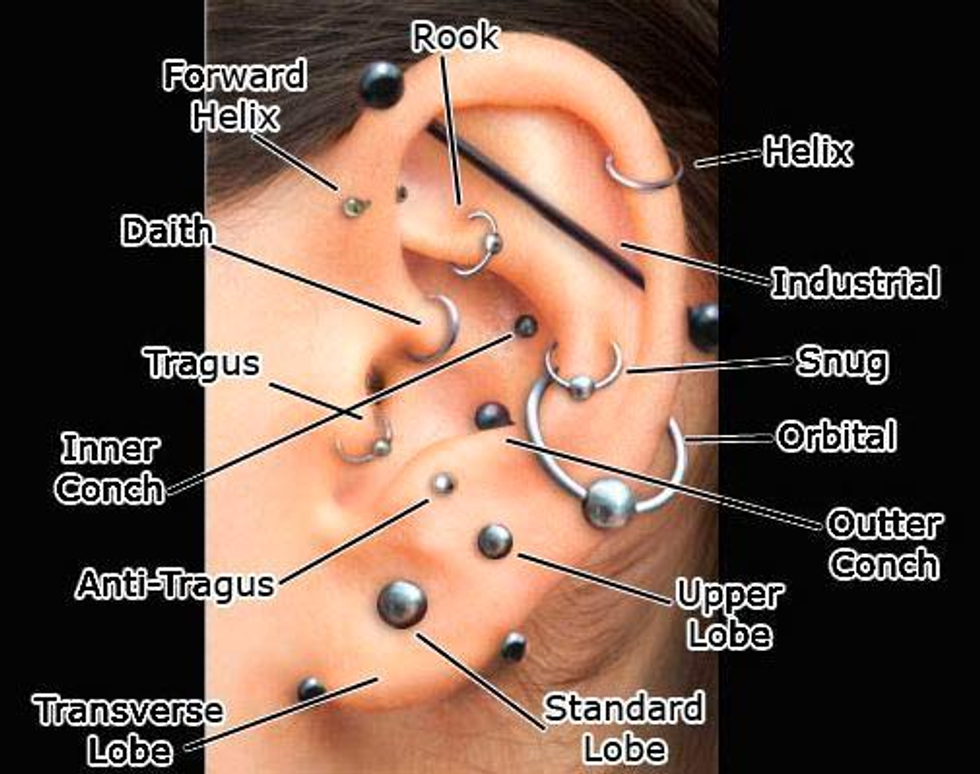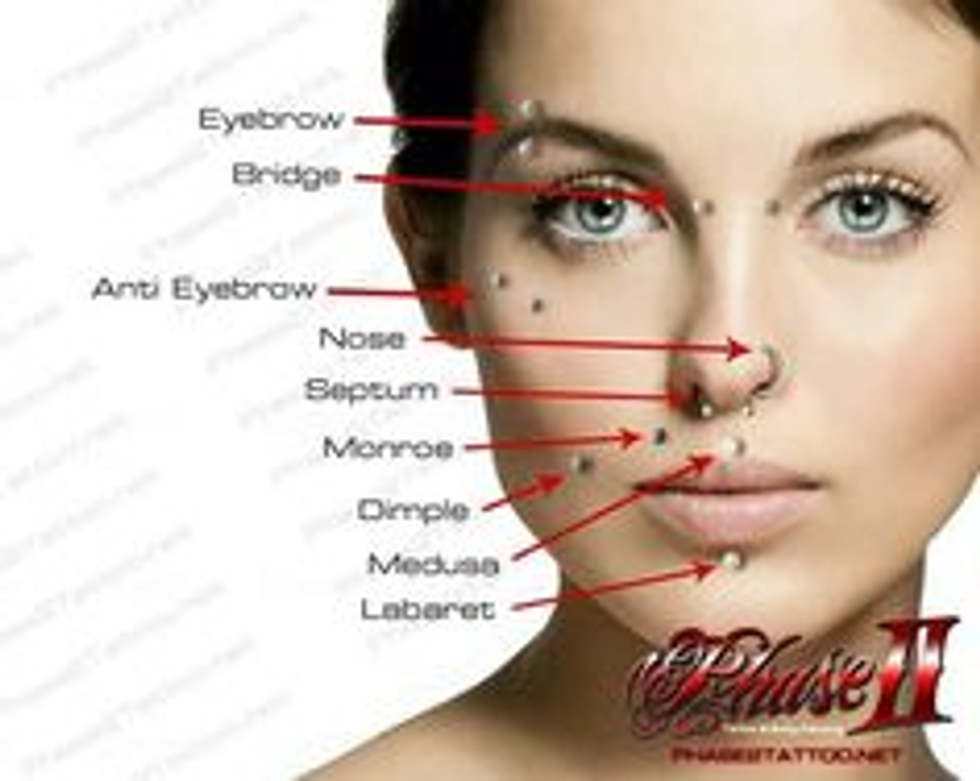There doesn’t have to be a special occasion to get a new piercing — take it from me. I’ve just got my ninth one done within the hour, so I’m going to give some wise words on dealing with piercings from finding where to go to jewelry to aftercare.
First off, you need to know what you want to get. My favorite place to surf for piercings is Pinterest, but in terms of location and terminology, here’s a handy-dandy guide:
Personally, I started with the single lob (one of each ear), then got a triple forward helix, followed it with a double helix. Afterwards, I got a nose piercing, and now I’ve added a conch (or if you look at the guide above, an orbital).
If you’re interested in facial piercings, here’s a chart for that:
One thing some people like to keep in mind is pain tolerance. In reality, I like to remember that the pain is relatively fast. I also think I read somewhere that the brain doesn’t remember pain, whether or not that’s true, I’d like to think it is. Bottom line: no pain, no gain. If you think it looks great, then go for it—that’s all that matters.
Well, that’s not really all that matters...where you go is also very important for a couple reasons:
1. You want to make sure you are getting top quality jewelry (aka surgical steel).
Yes, it might be expensive, but it can make the difference between you putting time, money, and effort into a piercing that only gets infected and wastes more of your time, money, and effort.
2. You want to make sure the place you are going is sterile.
The cleanliness of the place is also one of best ways to ward off infection.
3. You want to make sure the person poking you actually knows what they’re doing.
This is especially important if you’re getting a non-lobe piercing, and it’s here that I’m going to go on a short rant about getting pierced with a gun at a place like Claire’s. Getting pierced with a gun is less accurate than a needle, and it can sometimes leave a flap of skin that later heals over the piercing. The gist: the needle is safer, more precise, and if someone know’s what they’re doing, they’ll probably pierce you with a needle. For a final point on who pokes you matters, many states have lax laws on who can be a piercer and you don’t just want anyone.
So, to help you weed through shady piercing places, the Associate of Professional Piercers has a handy dandy search tool that allows you to find one of their members in your area: http://www.safepiercing.org/
Now, say you’ve found a place and know what you’re looking to get, when you go, the piercer will check out your ear first to make sure the piercing you’re looking to get actually works with your ear or body. For instance, not everyone has the space for a full triple forward helix or even for a single—the piercer will be able to tell you this. Another thing they might tell you is that the jewelry (usually in regards to hoops) is too thin because even though you might want a simple silver hoop, getting pierced with a thicker needle might be for the better so that if you want to change out the jewelry later on, anything will fit. Otherwise, trying to put in a larger stud to a smaller hole will be more than a bit uncomfortable and even painful. In the end, what the piercer says should pretty much go.
Speaking of types of jewelry, here’s a guide to what kind of jewelry you can get, here's another handy dandy link with types of body jewelry.
On a side note on my preferences: when it comes to nose studs, I prefer a screw to an 'L' even though the L is easier to take out. The screw makes it so it's curved to your nostril and provides more of a snug fit. However, your piercer will probably start you with an 'L', but don't worry, they can rework the jewelry later on if you so choose.
Depending on where you get pierced, there will be different selections of jewelry to choose from, you can figure this out for yourself when you go.
In regards to aftercare and where you go, they might give you some soap to use to wash your piercings and/or some salt. A good brand for the soap is “Octi-scrub,” and something you might find worthwhile and depending where the piercing is located, warm salt water soaks does wonders for helping a new piercing heal. Personally, after soaking my ear in a cup of warm water twice a day for months, I decided to try a different route to save my neck the strain, and so I discovered H2Ocean. With just a spray or two a day, I found that my piercing healed way faster than doing the soaks. Another good alternative is a saline solution like contact solution and a q-tip. Though they tell you to not use q-tips, I do. Again, listen to your piercer on this, but as long as you’re careful and not getting it snagged, you should be just fine. Also, be sure to not wash the piercing all the time because that will only irritate it more. I tend to just wash it while I’m in the shower every day to every other day. Another good thing to keep in mind during the healing process, which can last between 4 to 6 months depending, is to take Ibuprofen for swelling and not tylenol, which can actually lead to inflammation.
Other things to be weary of:
Try not to sleep on the piercing, which can be easier said than done, but after waking up with a throbbing ear, you’ll be sure to sleep on your other side or, do what I do, and get one of those travel neck pillows and sleep on it so that your ear isn’t making contact and is nestled in the hole. Also, while it may be hard to resist, try not to play with the jewelry all that much, it’ll just take longer to heal.
In case of infection, which is more or less bound to happen to some extent, you should do warm salt water soaks simply because it will feel better, or one time, I had a friend (an amazing friend) help squeeze out the blood and reduce the swelling to relieve the pain. Unsure if a piercer would recommend that tactic, but it did wonders for me when it came to healing my double helix. Also, if you find that the jewelry is too tight with the swelling (when you first get it, they will make it a bit loose to account for swelling), go back to the studio to have them extend it, so your body doesn’t swallow the jewelry, which can happen if you aren’t careful. Another word from the wise, don’t take out jewelry when it’s infected, all this will do is seal the infection in your body, which has the potential of making you sick later on.
A couple final notes on stud vs. hoop:
Sometimes, you’ll hear that getting a hoop has a longer healing time or that it will heal with a curve and hurt later if you switch to a stud, while perhaps there might be a time difference of a couple weeks or even a tad discomfort when you switch from a hoop to a stud, if it’s what you want, you should get it. On this, a piercing usually won't tell you otherwise unlike the gauge of the needle. However, do be aware that the placement of a nose ring can vary from placement of a stud, so if there is a chance that you might want to interchange, make sure the placement can accommodate both.
In the end, pierce what you want, where you want, and for whatever reason because in the end, you can always take it out.























